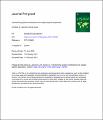| dc.contributor.author | Jacknick, Christine M. | |
| dc.contributor.author | Duran, Derya | |
| dc.date.accessioned | 2021-03-03T07:46:12Z | |
| dc.date.available | 2021-03-03T07:46:12Z | |
| dc.date.issued | 2021 | |
| dc.identifier.citation | Jacknick, C. M., & Duran, D. (2021). Transforming student contributions into subject-specific expression. <i>System</i>, <i>98</i>, Article 102485. <a href="https://doi.org/10.1016/j.system.2021.102485" target="_blank">https://doi.org/10.1016/j.system.2021.102485</a> | |
| dc.identifier.other | CONVID_51639132 | |
| dc.identifier.uri | https://jyx.jyu.fi/handle/123456789/74482 | |
| dc.description.abstract | Drawing on a corpus of pre-service teacher training classroom interactions in an English-medium instruction university in Turkey, we examine teacher follow-up turns that introduce specialized terms, showing how a teacher transforms student’s responses into pedagogically relevant points using academic language. We argue that teacher third-turns following student contributions accomplish several interrelated actions, not only introducing new terminology to these teachers-in-training, but also familiarizing them with ways of thinking specific to their discipline, i.e., these turns model “doing being a teacher.” These teacher actions are used to bridge student contributions to more scientific talk, that is, the teacher confirms contributions as subject-relevant by steering the direction of the upcoming talk, while also introducing students to potentially unfamiliar terminology, speaking as a member of an unnamed group of subject-matter experts. Notably, we argue that these content-based follow-ups are realized multimodally, drawing on prosodic, gestural, and proxemic resources, among others, and that these multimodal actions are an important aspect of teacher’s classroom interactional competence, showing how instructors socialize pre-service teachers into thinking and talking like professionals, i.e., like teachers. | en |
| dc.format.mimetype | application/pdf | |
| dc.language | eng | |
| dc.language.iso | eng | |
| dc.publisher | Elsevier | |
| dc.relation.ispartofseries | System | |
| dc.rights | CC BY-NC-ND 4.0 | |
| dc.subject.other | classroom interaction | |
| dc.subject.other | conversation analysis | |
| dc.subject.other | English-medium instruction | |
| dc.subject.other | higher education | |
| dc.subject.other | subject-specific language | |
| dc.subject.other | teacher follow-up | |
| dc.title | Transforming student contributions into subject-specific expression | |
| dc.type | article | |
| dc.identifier.urn | URN:NBN:fi:jyu-202103031844 | |
| dc.contributor.laitos | Kieli- ja viestintätieteiden laitos | fi |
| dc.contributor.laitos | Department of Language and Communication Studies | en |
| dc.type.uri | http://purl.org/eprint/type/JournalArticle | |
| dc.type.coar | http://purl.org/coar/resource_type/c_2df8fbb1 | |
| dc.description.reviewstatus | peerReviewed | |
| dc.relation.issn | 0346-251X | |
| dc.relation.volume | 98 | |
| dc.type.version | acceptedVersion | |
| dc.rights.copyright | © 2021 Elsevier | |
| dc.rights.accesslevel | openAccess | fi |
| dc.subject.yso | keskustelunanalyysi | |
| dc.subject.yso | luokkatyöskentely | |
| dc.subject.yso | kielellinen vuorovaikutus | |
| dc.subject.yso | korkeakouluopetus | |
| dc.format.content | fulltext | |
| jyx.subject.uri | http://www.yso.fi/onto/yso/p7828 | |
| jyx.subject.uri | http://www.yso.fi/onto/yso/p568 | |
| jyx.subject.uri | http://www.yso.fi/onto/yso/p7831 | |
| jyx.subject.uri | http://www.yso.fi/onto/yso/p1246 | |
| dc.rights.url | https://creativecommons.org/licenses/by-nc-nd/4.0/ | |
| dc.relation.doi | 10.1016/j.system.2021.102485 | |
| jyx.fundinginformation | This research was supported by Turkish Fulbright Commission under the grant number FY-2018-TR-PD-06. | |
| dc.type.okm | A1 | |

